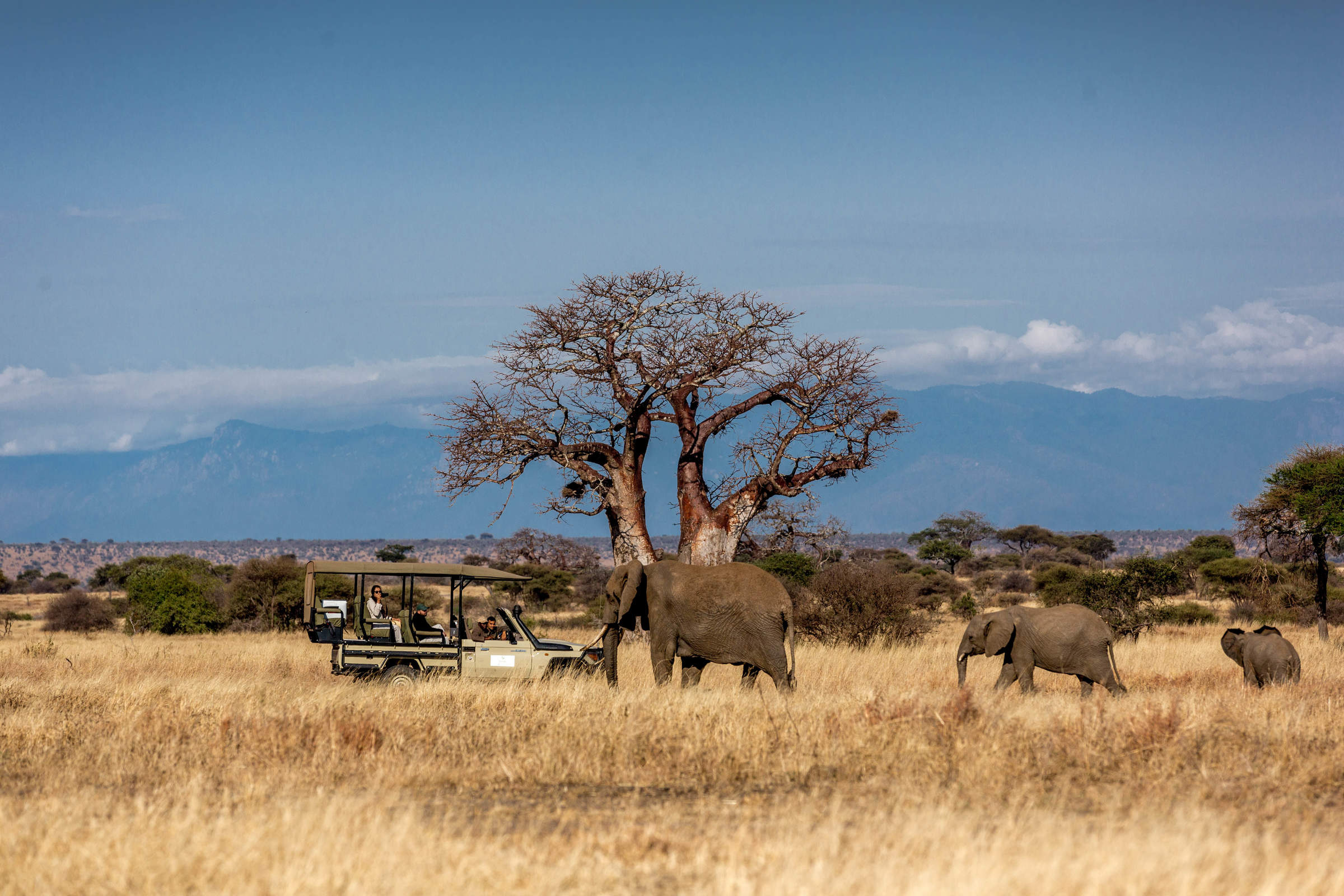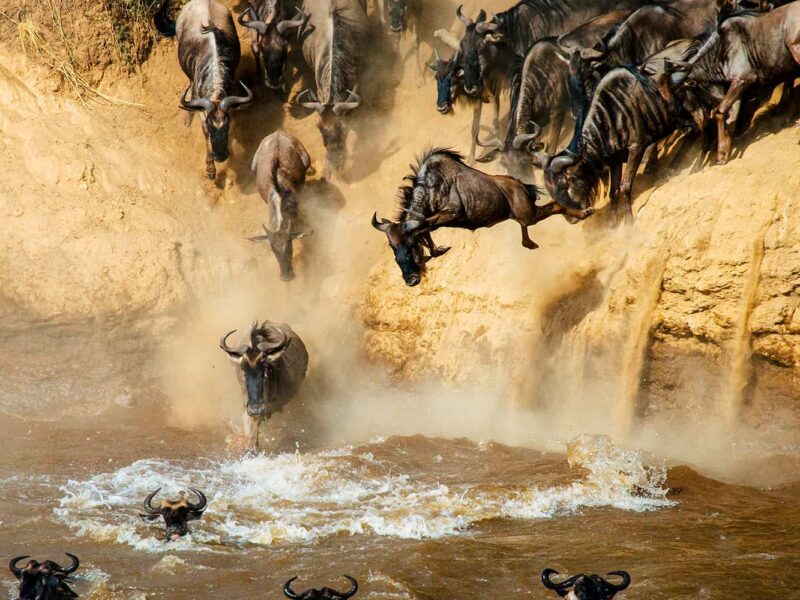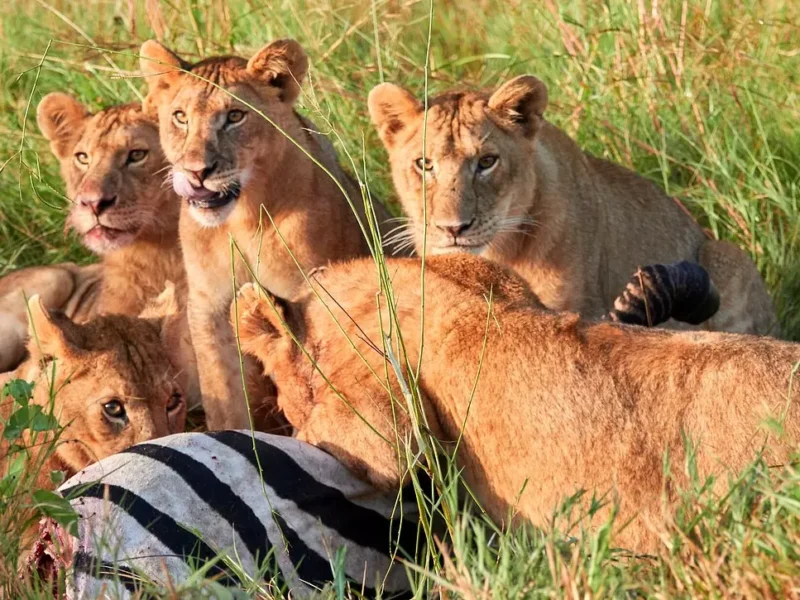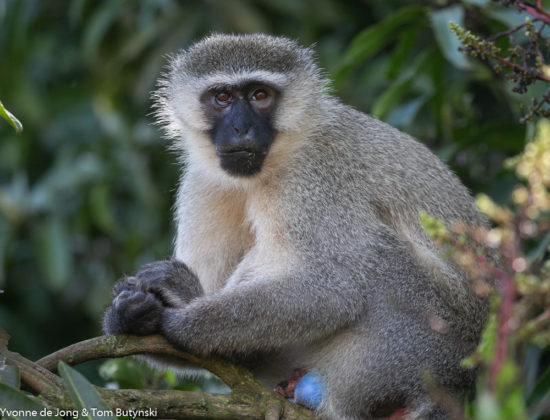
Monkeys in Uganda
April 10, 2025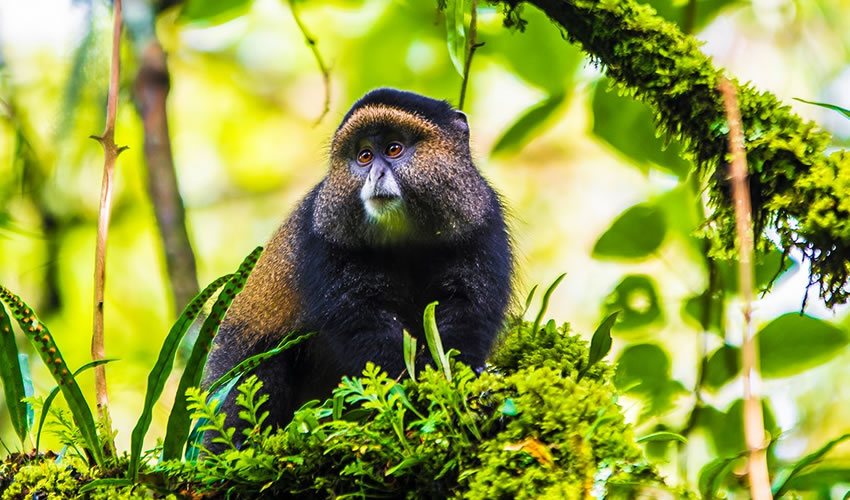
Golden monkeys in Uganda
April 11, 2025Tarangire National Park
Overview of Tarangire National Park
Location: Northern Tanzania, about 118 km (75 miles) southwest of Arusha
Established: 1970
Size: Approximately 2,850 square kilometers (1,100 square miles)
Tarangire National Park is a spectacular wildlife reserve in Tanzania, known for its stunning landscapes and rich biodiversity. It forms part of Tanzania’s popular Northern Safari Circuit, alongside Serengeti, Ngorongoro Crater, and Lake Manyara.
The park is especially famous for its large herds of elephants and the ancient baobab trees that dot the savannah. During the dry season (June to October), the Tarangire River becomes a magnet for wildlife, attracting thousands of animals, including zebras, wildebeests, giraffes, buffalo, lions, leopards, and more. The park is also a birdwatcher’s paradise, with over 500 species recorded.
Tarangire is less crowded than some of the other big-name parks, offering a more relaxed and intimate safari experience. Its varied habitats—ranging from riverine forests and swamps to grasslands—support a wide range of flora and fauna, making it a must-visit for nature enthusiasts.
Would you like more info on the best time to visit, safari options, or animals you’re likely to see?
History and Heritage of Tarangire National Park
Introduction
Tarangire National Park, located in northern Tanzania, is not only known for its stunning landscapes and wildlife but also for its rich cultural and historical heritage. Officially established in 1970, the park is a significant part of Tanzania’s conservation story, shaped by centuries of indigenous habitation, traditional land use, and modern efforts to protect natural ecosystems.
Pre-Colonial and Indigenous Heritage
Before the establishment of the park, the area around Tarangire was inhabited and used by indigenous communities, particularly the Maasai and Barabaig people. These semi-nomadic pastoralists have lived in harmony with the land and wildlife for generations, using sustainable grazing patterns and maintaining a spiritual and cultural connection with the natural world.
– The Maasai regard many of the animals in the park, especially lions and elephants, with both reverence and respect, often incorporating them into their folklore and traditions.
– The Barabaig, an ethnic subgroup of the Datooga, traditionally occupied the highlands south of Tarangire. They practiced livestock herding and shifting agriculture, and their presence can still be felt in the surrounding areas today.
These communities used the land seasonally, moving with their herds in rhythm with the seasons—an early example of ecological coexistence that shaped the park’s early identity.
Colonial Period and the Path to Protection
During the early 20th century, under German and later British colonial rule, Tanzania (then called Tanganyika) experienced a shift in land use. The colonial governments began to identify certain areas for wildlife preservation and tourism potential.
– In 1957, the area was declared the Tarangire Game Reserve to protect it from overgrazing and poaching, particularly due to the region’s importance as a migratory corridor.
– After several studies and growing interest in conservation, the reserve was upgraded to national park status in 1970, under the authority of the newly established Tanzania National Parks Authority (TANAPA).
This transition marked a significant moment in Tanzanian conservation history, balancing ecological protection with the needs of surrounding communities.
Cultural Landscape and Spiritual Heritage
Though now protected, the land within and around Tarangire still holds spiritual and cultural value for the local people. Certain trees, especially the baobabs, are considered sacred, often used in traditional ceremonies and storytelling. The land itself is seen as a living entity, deeply tied to the identity and history of the Maasai and Barabaig peoples.
In many ways, the park is a living cultural landscape where stories, ancestral paths, and seasonal movements have been shaped over centuries.
Conservation and Modern Heritage
Today, Tarangire stands as a testament to Tanzania’s progressive conservation efforts. It is not only a haven for elephants and birdlife but also a symbol of cooperation between nature, heritage, and modern tourism.
Efforts have been made to:
– Involve local communities in conservation through community-based tourism and employment.
– Allow for cultural tourism programs, where visitors can learn about the Maasai lifestyle, traditions, and their relationship with nature.
– Protect wildlife corridors that allow animals to migrate beyond the park’s boundaries—many of which follow the same paths used by local pastoralists for centuries.
The history and heritage of Tarangire National Park go far beyond its boundaries and wildlife. It is a place where ancient traditions meet modern conservation, where the footprints of elephants follow the same paths once used by indigenous herders, and where the land tells stories of both natural wonder and human resilience. Recognizing and preserving this heritage is essential—not just for the park’s future, but for the cultural legacy of Tanzania as a whole.
Let me know if you’d like this adapted into a brochure, documentary script, or educational resource!
Geography and Landscape of Tarangire National Park
Location and Size
Tarangire National Park is located in northern Tanzania, within the Manyara Region, approximately 118 kilometers (about 2 hours’ drive) southwest of Arusha. It is part of Tanzania’s renowned Northern Safari Circuit, making it easily accessible from other major parks like Serengeti, Lake Manyara, and Ngorongoro Crater.
The park covers an area of about 2,850 square kilometers (1,100 square miles), making it the sixth-largest national park in Tanzania. Its landscape is diverse and supports one of the most varied ecosystems in East Africa.
Topography and Terrain
The terrain of Tarangire is a dynamic blend of rolling hills, river valleys, swamps, open woodlands, and grasslands. The park’s elevation varies between 900 and 1,250 meters above sea level, creating a mix of dry and wet zones that support a rich variety of plant and animal life.
Some key geographical features include:
– Tarangire River: The park’s defining feature and its namesake, the Tarangire River is a year-round water source that flows through the park from south to north. It becomes a crucial life-support system during the dry season, attracting massive numbers of wildlife.
– Seasonal Swamps and Wetlands: These areas are primarily found in the southern and central parts of the park. They fill with rainwater during the wet season and turn into lush, green habitats, especially important for birds and aquatic species.
– Hills and Escarpments: Scattered ridges and gentle hills provide scenic viewpoints and varied habitats. These elevations often serve as vantage points for predators and nesting grounds for birds.
Vegetation and Landscapes
Tarangire’s landscape is one of its most visually striking aspects. The park is a mosaic of different vegetation zones, including:
– Baobab Woodlands: Towering baobab trees (Adansonia digitata) dominate large areas of the park. These ancient trees, some estimated to be over 1,000 years old, provide food, shelter, and a striking visual identity to the landscape. Elephants are often seen digging into baobab trunks during the dry season for moisture.
– Acacia Woodlands: Thorny acacia trees create open woodland areas that are home to giraffes, antelopes, and a variety of bird species.
– Open Grasslands: These savannah areas support grazing animals like zebras, wildebeests, and buffalo. They are also prime hunting grounds for predators like lions and cheetahs.
– Floodplains and Wetlands: During the rainy season, seasonal swamps such as the Silale Swamp expand and become critical habitats for birdlife and water-dependent animals like hippos and elephants.
Climate and Seasons
Tarangire experiences a semi-arid climate with distinct wet and dry seasons:
– Dry Season (June–October): Characterized by sparse vegetation, clear skies, and excellent game viewing around the river. This is when the park’s geography really shows its contrasts—dry plains against green riverbanks.
– Wet Season (November–May): The landscape transforms into lush, green expanses. Grasslands grow thick, and seasonal wetlands fill, supporting a burst of life and bird activity.
Geological Features
The park lies within the Gregory Rift Valley, part of the larger East African Rift system. This ancient tectonic activity has shaped the land over millions of years, creating a series of basins, escarpments, and alluvial plains that contribute to the park’s varied geography.
The geography and landscape of Tarangire National Park are as diverse and fascinating as its wildlife. From ancient baobab forests and dry savannahs to lush riverbanks and seasonal swamps, the park offers an ever-changing tapestry of East African wilderness. This variety not only enhances the beauty of the park but also makes it a vital habitat for a wide range of species, playing a crucial role in Tanzania’s ecological heritage.
Would you like a visual map or diagram to go with this? I can help generate one too.
Wildlife in Tarangire National Park
Introduction
Tarangire National Park, located in northern Tanzania, is one of East Africa’s most remarkable wildlife sanctuaries. Covering approximately 2,850 square kilometers, the park is celebrated for its exceptional biodiversity and particularly high concentration of animals during the dry season. Its mix of habitats—including savannah, riverine forest, swamps, and acacia woodlands supports a wide range of mammals, birds, and reptiles.
Iconic Mammals
1. Elephants
Tarangire is best known for its large elephant population, one of the highest in Tanzania. Herds of up to 300 individuals can be seen, especially during the dry season (June to October) as they migrate from surrounding areas to the Tarangire River, the park’s only permanent water source. The park provides an excellent opportunity to observe elephant behavior, including bathing, social interaction, and tree-bark feeding.
2. Big Cats
– Lions are frequently spotted in the open savannah and woodlands, often lying in the shade during the heat of the day or stalking prey during early mornings and late evenings.
– Leopards tend to be more elusive but are often seen in the trees near riverbanks.
– Cheetahs, while less common, can be seen in the southern plains where open landscapes make ideal hunting grounds.
3. Herbivores
The park hosts a diverse array of grazers and browsers:
– Zebras and wildebeests, often seen migrating together
– Giraffes, feeding on acacia trees
– Buffalo, particularly near the river and swamps
– Eland, impala, waterbuck, and Grant’s gazelles
4. Rare and Unique Species
Tarangire is one of the few parks in northern Tanzania where you can spot:
– Fringe-eared oryx
– Gerenuk (the “giraffe gazelle”)
– Greater and lesser kudu
– African wild dogs (sightings are rare but increasingly reported)
Birdlife
Tarangire is a paradise for birdwatchers, with over 500 species recorded. Its mix of habitats—from wetlands to dry woodlands—provides sanctuary for both resident and migratory birds. Some notable species include:
– Yellow-collared lovebird (endemic to the region)
– Ashy starling
– Kori bustard (the heaviest flying bird in Africa)
– Secretary bird
– African fish eagle
– Lilac-breasted roller
– Hornbills, bee-eaters, and kingfishers
Seasonal swamps like Silale Swamp attract water birds such as:
– Pelicans
– Herons
– Egrets
– Storks
– Flamingos(occasionally)
Reptiles and Amphibians
While less visible, Tarangire is also home to various reptiles and amphibians, especially near wetland areas. These include:
– Nile crocodiles in rivers and swamps
– Monitor lizards
– Chameleons
– Geckos
– Various species of frogs during the rainy season
Insects and Smaller Fauna
The park also supports a wide variety of insects, including beautiful butterflies, beetles, and ants. Termite mounds are commonly seen across the landscape and play a vital role in the ecosystem by aerating the soil and supporting plant growth.
Seasonal Migrations
One of the most fascinating aspects of Tarangire’s wildlife is its seasonal migration. During the dry season, thousands of animals—including elephants, zebras, wildebeests, and antelopes—migrate into the park from the surrounding Maasai Steppe in search of water. This phenomenon makes Tarangire one of the best places in Tanzania to witness large concentrations of wildlife in a relatively compact area.
Conservation and Challenges
Tarangire plays a critical role in the conservation of migratory corridors and elephant populations in northern Tanzania. However, threats such as human-wildlife conflict, climate change, and encroachment from agricultural expansion around the park pose ongoing challenges. Conservation efforts aim to integrate local communities through eco-tourism, education, and community-managed wildlife corridors.
Climate of Tarangire National Park
Introduction
Tarangire National Park, located in northern Tanzania, experiences a semi-arid climate, typical of the East African savannah. Its climate plays a significant role in shaping the park’s ecosystems, wildlife behavior, and visitor experiences. The seasonal variations in rainfall and temperature directly influence animal migrations, vegetation cover, and overall safari conditions.
Seasons in Tarangire
Tarangire has two main seasons a dry season and a wet season, each offering a different perspective on the park’s natural beauty.
Dry Season (June to October)
This is the peak safari season and the driest part of the year.
-Weather Conditions
– Warm days and cool nights
– Clear skies with very little rainfall
– Daytime temperatures range from 25°C to 30°C (77°F to 86°F)
– Night temperatures can drop to 10°C to 15°C (50°F to 59°F)
-Landscape and Vegetation:
– Vegetation becomes sparse and brown
– Water sources dry up, except for the Tarangire River, which remains a critical lifeline
– Wildlife Activity:
– Ideal time for game viewing, as animals gather around the river and remaining waterholes
– Large herds of elephants, zebras, buffalo, and various antelope species are highly concentrated
– Predators such as lions and leopards are easier to spot due to the thinner bush
Wet Season (November to May)
This season is marked by periodic rains and lush green landscapes.
Divided into:
– Short rains (November to December)
– Long rains (March to May)
-Weather Conditions:
– Warmer and more humid conditions
– Daytime temperatures: 27°C to 32°C (80°F to 90°F)
– Rain often comes in short, heavy bursts, especially in the afternoons
– Long rains (especially April) can bring prolonged wet periods
– Landscape and Vegetation:
– The park becomes lush and green
– Grass and foliage grow rapidly, transforming the scenery
– Rivers and swamps swell, and seasonal pools for
– Wildlife Activity:
– Animals are more dispersed due to abundant water sources
– Birdwatching is excellent, with many migratory bird species present
– The park is less crowded with tourists, offering a more serene experience
Best Time to Visit Based on Climate
– Best for Wildlife Viewing:
June to October – dry season when animals are most visible
– Best for Birdwatching and Scenery:
November to March – green season with lush landscapes and migratory birds
Climate’s Role in Ecology
The climate of Tarangire not only affects tourism but also:
– Dictates animal migration patterns, especially the seasonal movement of elephants and ungulates
– Influences vegetation growth, affecting food availability
– Plays a crucial role in the hydrology of the Tarangire River and seasonal swamps, which are vital to the park’s biodiversity
The climate of Tarangire National Park is a dynamic force that shapes its natural rhythms. With its hot, dry months and lush, rainy seasons, the park offers two distinct safari experiences. Whether you’re drawn by the drama of the dry season or the renewal of the rains, Tarangire remains a compelling destination year-round.
Would you like this summarized into a climate chart or a visitor-friendly seasonal guide? I can help with that too!
Absolutely! Here’s a detailed write-up on the conservation efforts in Tarangire National Park, highlighting the initiatives, challenges, and community involvement that help protect this vital ecosystem:
Conservation Efforts in Tarangire National Park
Tarangire National Park is not only a haven for wildlife but also a cornerstone of Tanzania’s broader conservation network. Home to one of the largest elephant populations in East Africa, as well as rare species and crucial migratory corridors, the park plays a vital role in preserving biodiversity. However, increasing human pressures, habitat loss, and climate change pose serious threats. In response, a range of conservation efforts have been implemented—focusing on wildlife protection, habitat preservation, community engagement, and sustainable tourism.
Wildlife Protection and Anti-Poaching
One of the core goals of conservation in Tarangire is to protect its rich and diverse wildlife, particularly its iconic elephant herds, which were heavily targeted by poachers in the past.
-TANAPA (Tanzania National Parks Authority) plays a leading role in managing and protecting the park through:
– Anti-poaching patrols
– Surveillance systems
– Law enforcement and ranger training
– Elephant conservation has seen particular focus, with support from NGOs and international partners. Improved protection has led to a gradual recovery in elephant numbers in recent years.
Habitat and Ecosystem Management
Tarangire’s ecosystem extends beyond its official boundaries. The park is part of a larger ecosystem and wildlife migration corridor that includes surrounding community lands and private conservancies.
-Conservationists work to protect wildlife corridors used by migrating animals during the dry season, especially:
– The Kwakuchinja corridor, which links Tarangire to Lake Manyara National Park
– Seasonal movement routes for elephants, wildebeests, and zebras
-Initiatives include:
– Land-use planning with local governments and communities
– Promoting sustainable grazing practices outside park boundaries
– Preserving natural vegetation and water sources
Community Involvement and Eco-Tourism
Conservation in Tarangire is closely tied to the well-being of local communities, including the Maasai and Barabaig people, who have traditionally lived in and around the park.
– Projects aim to empower local communities through:
– Community-Based Natural Resource Management (CBNRM)
– Eco-tourism initiatives that create jobs in lodges, guiding, and crafts
– Benefit-sharing programs, where a portion of tourism revenue goes to local development (schools, clinics, water access)
-Cultural tourism programs also help raise awareness and appreciation for both the environment and the indigenous cultures that have coexisted with it for generations.
Environmental Education and Research
Long-term conservation success depends on education and scientific understanding.
– Environmental education programs are run in schools near the park to foster conservation values among youth.
– The park hosts various research projects focusing on:
– Wildlife migration and behavior
– Elephant movements and human-wildlife conflict
– Climate change impacts on local ecosystems
Researchers and conservationists use GPS tracking, camera traps, and ecological monitoring to inform adaptive management strategies.
Challenges to Conservation
Despite progress, several challenges remain:
– Encroachment and habitat loss due to expanding agriculture and settlements
– Human-wildlife conflict, especially with elephants damaging crops
– Climate change, affecting water availability and vegetation patterns
– Limited funding and resources for enforcement and community programs
Success Stories
– Elephant population recovery: Thanks to anti-poaching efforts, elephant numbers have improved in the past decade.
– Community-managed wildlife corridors have been created to allow animal movement outside the park while still protecting farmland and human interests.
– Growth in sustainable tourism has increased awareness and funding for conservation activities.
The conservation efforts in Tarangire National Park represent a blend of science, tradition, and collaboration. By combining strong wildlife protection with community engagement and sustainable tourism, the park serves as a model for how protected areas can thrive in the face of modern environmental challenges. Continued support from local stakeholders, government bodies, NGOs, and visitors is essential to safeguard this irreplaceable landscape for future generations.
Accommodation in Tarangire National Park
Whether you’re a luxury traveler, a mid-range explorer, or a budget-conscious adventurer, Tarangire National Park offers a wide range of accommodation options to suit every taste and experience. Set against the stunning backdrop of baobab-dotted landscapes and teeming wildlife, staying in or near the park allows visitors to immerse themselves in the beauty and serenity of the Tanzanian wilderness.
Types of Accommodation
1. Luxury Lodges
Perfect for those seeking comfort, exclusivity, and incredible service, luxury lodges in Tarangire offer:
– Spacious rooms or private tented suites
– Private decks with views of the bush or river
– Gourmet dining and personal service
– Swimming pools, spas, and private game drives
Popular Luxury Lodges:
– Tarangire Treetops by Elewana – Unique treehouse-style rooms set in ancient baobabs, with panoramic views and luxury amenities.
– Sanctuary Swala Camp – Remote and elegant, located in a private area of the park with frequent wildlife sightings.
– Lemala Mpingo Ridge Lodge – A hilltop lodge with sweeping views and luxurious suites with outdoor bathtubs.
2. Mid-Range Lodges & Tented Camps
These provide a balance between comfort and affordability. You can expect:
– Comfortable beds and en-suite bathrooms
– Delicious meals and friendly staff
– Guided safari drives and bush walks
Popular Mid-Range Options:
– Tarangire Safari Lodge – One of the oldest lodges in the park, known for its scenic cliff-top location overlooking the Tarangire River.
– Sangaiwe Tented Lodge – Located near the park gate, it offers eco-friendly tented rooms with stunning views of the plains.
– Lake Burunge Tented Camp – Positioned on the shores of Lake Burunge, just outside the park, with great access to both Tarangire and Manyara.
3. Budget Campsites & Basic Accommodations
For travelers who prefer a close-to-nature experience or are on a tighter budget, there are:
– Public and special campsites within or just outside the park
– Basic lodges with shared facilities or simpler tented camps
Examples:
– Zion Campsite (outside the park gate) – Popular among self-drive tourists and backpackers
– Public campsites inside the park, managed by TANAPA – Must be booked in advance, and guests should bring their own camping gear or rent from safari operators
Eco-Friendly and Community-Based Lodges
Many accommodations in and around Tarangire operate with eco-conscious principles:
– Use of solar power
– Rainwater harvesting systems
– Waste recycling programs
– Support for local employment and community development
Examples include:
– Baobab Tented Camp – Operates with sustainability in mind and partners with local communities
– Tarangire Ndovu Tented Lodge – A solar-powered camp that emphasizes low-impact tourism
Location of Lodges
– Inside the Park: Offers the best access to wildlife and early morning game drives without gate delays. Lodges inside the park are more exclusive and often more expensive.
– Just Outside the Park: Often more affordable and still very close to the action, these accommodations are usually located near Tarangire Gate (Main Gate) and Sangaiwe Gate.
What to Expect During Your Stay
– Guided game drives included or arranged through the lodge
– Bush dinners or sundowners overlooking the savannah
– Cultural tours to nearby Maasai or Barabaig villages
– Wi-Fi availability (limited or satellite-based in remote areas)
– Safety and comfort, with professional staff and secure facilities.
Staying in or around Tarangire National Park is not just about having a place to sleep—it’s about fully experiencing the magic of the African wilderness. Whether you’re relaxing in a luxurious tented suite under the stars or camping beside the sounds of the bush, the range of accommodations ensures that every traveler can enjoy the park in their own way. The warm Tanzanian hospitality, combined with breathtaking views and rich wildlife, makes a stay in Tarangire truly unforgettable.

